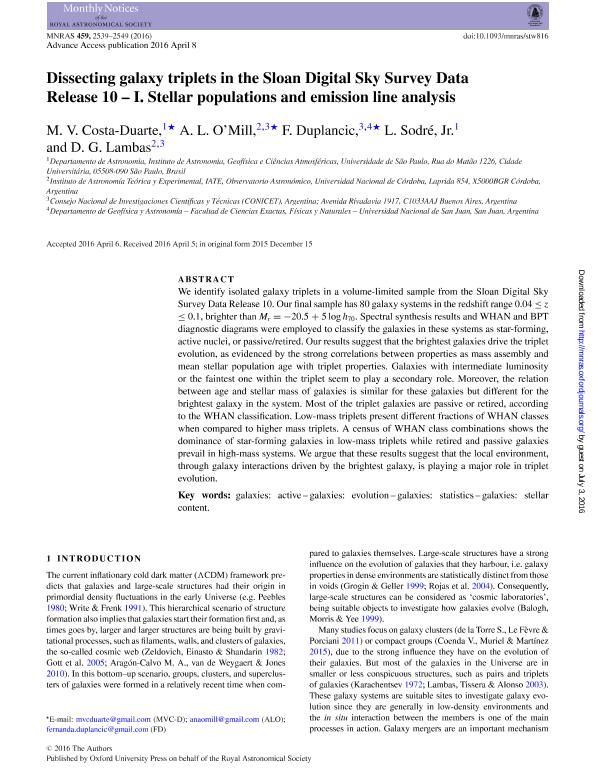Mostrar el registro sencillo del ítem
dc.contributor.author
Costa Duarte, Marcus Vinicius
dc.contributor.author
O'Mill, Ana Laura

dc.contributor.author
Duplancic Videla, Maria Fernanda

dc.contributor.author
Sodré, Laerte

dc.contributor.author
Garcia Lambas, Diego Rodolfo

dc.date.available
2018-05-15T19:29:47Z
dc.date.issued
2016-04
dc.identifier.citation
Costa Duarte, Marcus Vinicius; O'Mill, Ana Laura; Duplancic Videla, Maria Fernanda; Sodré, Laerte; Garcia Lambas, Diego Rodolfo; Dissecting galaxy triplets in the Sloan Digital Sky Survey Data Release 10 - I. Stellar populations and emission line analysis; Wiley Blackwell Publishing, Inc; Monthly Notices of the Royal Astronomical Society; 459; 3; 4-2016; 2539-2549
dc.identifier.issn
0035-8711
dc.identifier.uri
http://hdl.handle.net/11336/45258
dc.description.abstract
We identify isolated galaxy triplets in a volume-limited sample from the Sloan Digital Sky Survey Data Release 10. Our final sample has 80 galaxy systems in the redshift range 0.04 ≤ z ≤ 0.1, brighter than Mr = −20.5 + 5 log h70. Spectral synthesis results and WHAN and BPT diagnostic diagrams were employed to classify the galaxies in these systems as star-forming, active nuclei, or passive/retired. Our results suggest that the brightest galaxies drive the triplet evolution, as evidenced by the strong correlations between properties as mass assembly and mean stellar population age with triplet properties. Galaxies with intermediate luminosity or the faintest one within the triplet seem to play a secondary role. Moreover, the relation between age and stellar mass of galaxies is similar for these galaxies but different for the brightest galaxy in the system. Most of the triplet galaxies are passive or retired, according to the WHAN classification. Low-mass triplets present different fractions of WHAN classes when compared to higher mass triplets. A census of WHAN class combinations shows the dominance of star-forming galaxies in low-mass triplets while retired and passive galaxies prevail in high-mass systems. We argue that these results suggest that the local environment, through galaxy interactions driven by the brightest galaxy, is playing a major role in triplet evolution.
dc.format
application/pdf
dc.language.iso
eng
dc.publisher
Wiley Blackwell Publishing, Inc

dc.rights
info:eu-repo/semantics/openAccess
dc.rights.uri
https://creativecommons.org/licenses/by-nc-sa/2.5/ar/
dc.subject
Galaxies Active
dc.subject
Galaxies Evolution
dc.subject
Galaxies Statistics
dc.subject
Galaxies Stellar Content
dc.subject.classification
Astronomía

dc.subject.classification
Ciencias Físicas

dc.subject.classification
CIENCIAS NATURALES Y EXACTAS

dc.title
Dissecting galaxy triplets in the Sloan Digital Sky Survey Data Release 10 - I. Stellar populations and emission line analysis
dc.type
info:eu-repo/semantics/article
dc.type
info:ar-repo/semantics/artículo
dc.type
info:eu-repo/semantics/publishedVersion
dc.date.updated
2018-05-11T20:40:48Z
dc.journal.volume
459
dc.journal.number
3
dc.journal.pagination
2539-2549
dc.journal.pais
Reino Unido

dc.journal.ciudad
Londres
dc.description.fil
Fil: Costa Duarte, Marcus Vinicius. Universidade de Sao Paulo; Brasil
dc.description.fil
Fil: O'Mill, Ana Laura. Consejo Nacional de Investigaciones Científicas y Técnicas. Centro Científico Tecnológico Conicet - Córdoba. Instituto de Astronomía Teórica y Experimental. Universidad Nacional de Córdoba. Observatorio Astronómico de Córdoba. Instituto de Astronomía Teórica y Experimental; Argentina
dc.description.fil
Fil: Duplancic Videla, Maria Fernanda. Universidad Nacional de San Juan. Facultad de Ciencias Exactas, Físicas y Naturales. Departamento de Geofísica y Astronomía; Argentina. Consejo Nacional de Investigaciones Científicas y Técnicas; Argentina
dc.description.fil
Fil: Sodré, Laerte. Universidade de Sao Paulo; Brasil
dc.description.fil
Fil: Garcia Lambas, Diego Rodolfo. Consejo Nacional de Investigaciones Científicas y Técnicas. Centro Científico Tecnológico Conicet - Córdoba. Instituto de Astronomía Teórica y Experimental. Universidad Nacional de Córdoba. Observatorio Astronómico de Córdoba. Instituto de Astronomía Teórica y Experimental; Argentina
dc.journal.title
Monthly Notices of the Royal Astronomical Society

dc.relation.alternativeid
info:eu-repo/semantics/altIdentifier/doi/http://dx.doi.org/10.1093/mnras/stw816
dc.relation.alternativeid
info:eu-repo/semantics/altIdentifier/url/https://academic.oup.com/mnras/article-abstract/459/3/2539/2595212
Archivos asociados
